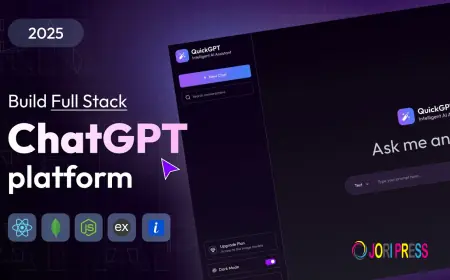12 Tips to Improve the Performance of React Native Mobile App
React Native has emerged as a dominant force in cross-platform mobile app development, enabling developers to build robust applications for iOS and Android from a single JavaScript codebase. Its popularity stems from its promise of faster development cycles, code reusability, and a "write once, run anywhere" philosophy. However, achieving native-like performance in React Native apps requires a deep understanding of its architecture and a commitment to optimization best practices. Without careful attention, React Native apps can suffer from performance bottlenecks, leading to janky animations, slow load times, and a frustrating user experience.
For any Mobile App Development USA company, delivering high-performing applications is paramount to client satisfaction, user retention, and market competitiveness. This guide provides 12 expert tips to help developers significantly improve the performance of their React Native mobile applications in 2025 and beyond.
1. Enable Hermes: The Optimized JavaScript Engine
Hermes is a JavaScript engine optimized for React Native, developed by Facebook (Meta). It significantly improves app startup time, reduces memory usage, and decreases app size, especially on Android devices.
-
Why it helps: Hermes pre-compiles JavaScript code into bytecode during the build process (ahead-of-time compilation), which is faster to parse and execute on the device compared to just-in-time compilation. This leads to quicker app launches and smoother runtime performance.
-
How to implement: For new React Native projects (0.64+), Hermes is often enabled by default. For existing projects, you can enable it in your
android/app/build.gradlefile by settingenableHermes: trueand ensuring the correct Hermes dependency. For iOS, Hermes support was introduced in React Native 0.64.
Relevance for Mobile App Development USA: Many Mobile App Development USA companies prioritize rapid deployment. Hermes directly contributes to this by making apps feel faster and more responsive from the first launch, which is crucial for user retention.
2. Optimize Image Handling and Caching
Images are often the largest assets in a mobile app and can significantly impact performance if not handled correctly.
-
Compress and Resize Images: Before bundling images into your app, ensure they are properly compressed and resized to the exact dimensions they will be displayed at. Tools like TinyPNG, ImageOptim, or online compressors can help reduce file size without significant quality loss.
-
Use Efficient Formats: Prefer modern image formats like WebP (supported on both Android and iOS) over JPEG or PNG where possible, as WebP offers superior compression. For vector graphics, use SVGs.
-
Implement Smart Caching: Leverage dedicated image loading libraries like
react-native-fast-image(orexpo-imagefor Expo projects). These libraries provide advanced caching mechanisms, prioritize image loading, and handle memory management more efficiently than the defaultImagecomponent. They store images locally, so subsequent loads are much faster. -
Lazy Load Images: Only load images when they are about to appear on the screen (e.g., as the user scrolls).
react-native-fast-imagesupports this, and for larger lists, combining it with virtualization (see Tip 4) is highly effective.
Relevance for Mobile App Development USA: Visual appeal is key to user engagement. Optimizing images ensures that apps look great without compromising on speed, a common demand from clients of any Mobile App Development USA firm.
3. Minimize Unnecessary Re-renders with Memoization
React Native components re-render when their props or state change. Unnecessary re-renders of components that haven't actually changed can lead to performance bottlenecks.
-
Use
React.memo(Functional Components): Wrap functional components withReact.memoto prevent re-renders if their props haven't changed. This performs a shallow comparison of props. -
Use
PureComponent(Class Components): For class components, extendReact.PureComponentinstead ofReact.Component. It automatically implementsshouldComponentUpdatewith a shallow prop and state comparison. -
useCallbackanduseMemoHooks:-
useCallback: Memoizes functions, preventing them from being recreated on every render if their dependencies haven't changed. This is crucial when passing functions as props toReact.memoized child components. -
useMemo: Memoizes expensive computations, ensuring they are only re-calculated if their dependencies change.
-
-
Avoid Inline Functions/Objects in JSX: Creating functions or objects directly within JSX (
rendermethod or functional component body) will cause them to be recreated on every render, breaking memoization for child components. Move them outside or useuseCallback/useMemo.
Relevance for Mobile App Development USA: Efficient rendering leads to smoother animations and a more responsive UI, which directly impacts user perception of app quality. This is a core aspect of delivering a premium user experience.
4. Optimize Large Lists with Virtualization
Displaying long lists of items (e.g., social media feeds, product catalogs) can be a major performance drain if not handled correctly.
-
Use
FlatListorSectionList: Always preferFlatList(for simple lists) orSectionList(for sectioned lists) overScrollViewfor large datasets. These components implement "virtualization," meaning they only render items that are currently visible on the screen, significantly reducing memory usage and rendering overhead. -
Provide
keyExtractor: Ensure you provide a uniquekeyExtractorprop toFlatList/SectionList. This helps React Native efficiently track item re-ordering and updates, preventing unnecessary re-renders. -
Optimize
renderItem: Keep therenderItemcomponent as lightweight as possible. Avoid complex logic or heavy components within each list item. Memoize yourrenderItemcomponent usingReact.memo. -
getItemLayout(for fixed-height items): If all your list items have a fixed height, providing thegetItemLayoutprop can be a huge performance boost. It allowsFlatListto skip expensive layout calculations. -
windowSizeandmaxToRenderPerBatch: Adjust these props to fine-tune how many items are rendered outside the viewport. A smallerwindowSizesaves memory but might cause blank areas during fast scrolling.
Relevance for Mobile App Development USA: Many modern apps are data-intensive and rely on lists. Optimizing these ensures a fluid scrolling experience, which is a hallmark of a well-built app.
5. Reduce the JavaScript Bundle Size
A large JavaScript bundle can significantly increase app startup time and memory consumption, especially on low-end devices.
-
Remove Unused Dependencies: Regularly audit your
package.jsonand remove any libraries or modules that are no longer used. Use tools likedepcheckto identify unused dependencies. -
Optimize Third-Party Libraries: Be mindful of the size of third-party libraries. If a library is very large but you only use a small portion of it, consider finding a more lightweight alternative or manually importing only the necessary parts if the library supports it.
-
Tree Shaking: Ensure your build process (especially with Hermes) effectively "tree shakes" your code, which means removing unused exports from your bundled JavaScript.
-
Code Splitting and Lazy Loading: For large apps with many screens or features, consider implementing code splitting. While not as straightforward as in web React, you can dynamically import components or screens using
React.lazy()andSuspense(for UI fallback) to load them only when needed. This reduces the initial bundle size. -
Use Android App Bundles (AAB): For Android, always publish your app as an Android App Bundle (
.aab) instead of a traditional APK. Google Play then generates optimized APKs tailored to each user's device, serving only the necessary resources and reducing download size.
Relevance for Mobile App Development USA: Smaller app sizes lead to higher download conversion rates and better user satisfaction, particularly for users with limited storage or data plans.
6. Leverage Native Modules for CPU-Intensive Tasks
While React Native bridges JavaScript to native code, some computationally intensive tasks are better performed directly on the native (Java/Kotlin for Android, Swift/Objective-C for iOS) thread.
-
Identify Bottlenecks: Use profiling tools (e.g., React Native Performance Monitor, Flipper, Xcode Instruments, Android Studio Profiler) to identify JavaScript thread bottlenecks. If a specific calculation or operation is consistently slowing down your app, it might be a candidate for a native module.
-
When to Use Native Modules: Consider native modules for tasks like:
-
Complex image processing or video manipulation.
-
Heavy data encryption/decryption.
-
Advanced mathematical computations.
-
Interacting directly with specific device hardware (e.g., Bluetooth, NFC) in a highly optimized way.
-
-
Existing Native Modules: Before writing your own, check if a well-maintained community-driven native module already exists for your needs (e.g.,
react-native-reanimatedfor animations,react-native-camerafor advanced camera functionalities).
Relevance for Mobile App Development USA: For high-performance applications (e.g., gaming, media editing, complex enterprise tools), leveraging native modules ensures a truly fluid and responsive experience, meeting the high expectations of the US market.
7. Optimize Animations with react-native-reanimated
The default Animated API in React Native runs animations on the JavaScript thread, which can lead to jank if the thread is busy. react-native-reanimated allows animations to run natively on the UI thread.
-
Why it helps:
react-native-reanimatedoffloads animation logic from the JavaScript thread to the native UI thread. This means animations remain smooth even if the JavaScript thread is busy with other tasks (e.g., processing data, handling network requests). -
How to implement: Replace the standard
AnimatedAPI withreact-native-reanimatedfor complex or long-running animations. It offers a more powerful and flexible API for creating highly performant animations.
Relevance for Mobile App Development USA: Smooth animations are a hallmark of a polished app. This directly impacts user perception and satisfaction, which is critical for a Mobile App Development USA company aiming for top-tier app experiences.
8. Efficient Network Requests and Caching
Network operations can introduce significant delays. Optimizing how your app interacts with APIs is crucial.
-
Minimize API Calls: Batch multiple related API calls into a single request where possible.
-
Implement Caching: Cache frequently accessed data locally (e.g., using libraries like
react-query,redux-persist, or local databases like SQLite/Realm). This reduces the need for repeated network requests and allows for offline functionality. -
Data Compression: Ensure your backend supports data compression (e.g., GZIP) for API responses to reduce payload size.
-
Handle Network State: Implement logic to detect network connectivity and provide appropriate feedback or offline functionality to users.
-
Prefetch Data: Intelligently prefetch data that users are likely to need next, but do so judiciously to avoid wasting bandwidth.
Relevance for Mobile App Development USA: Users expect instant access to data. Optimizing network interactions ensures a fast and reliable experience, even on less stable connections.
9. Use InteractionManager to Defer Non-Essential Tasks
InteractionManager allows you to defer long-running computations or complex UI updates until after any current animations or interactions have completed.
-
Why it helps: It ensures that critical UI animations and user interactions remain smooth and responsive by preventing heavy tasks from blocking the UI thread.
-
How to implement: Wrap non-essential, time-consuming tasks within
InteractionManager.runAfterInteractions().
import { InteractionManager } from 'react-native';
// ... inside your component or function
InteractionManager.runAfterInteractions(() => {
// Perform heavy computation or complex UI updates here
// This will run after any current animations/interactions
});
Relevance for Mobile App Development USA: This tip helps maintain a fluid user experience, especially during transitions or complex interactions, ensuring the app feels responsive and high-quality.
10. Optimize Memory Usage
High memory consumption can lead to app crashes, slowdowns, and poor battery life, particularly on low-end devices.
-
Clean Up Listeners and Subscriptions: Always unsubscribe from event listeners, clear timers (
setTimeout,setInterval), and close database connections inuseEffectcleanup functions (for functional components) orcomponentWillUnmount(for class components). Failing to do so can cause memory leaks. -
Avoid Large Objects in State: Be mindful of storing very large objects or arrays directly in a component's state, as this can lead to increased memory usage and re-render issues.
-
Use
FlatList/SectionList(again!): As mentioned in Tip 4, these components are crucial for memory efficiency when dealing with lists. -
Profile Memory: Regularly use profiling tools (Flipper's Memory Debugger, Xcode Instruments, Android Studio Profiler) to identify memory leaks and excessive memory usage.
Relevance for Mobile App Development USA: A stable app that doesn't crash or drain battery is essential for user satisfaction and positive app store reviews.
11. Implement Debouncing and Throttling
These techniques control how often a function is executed, preventing excessive calls that can lead to performance issues, especially for events that fire rapidly (e.g., text input, scrolling).
-
Debouncing: Delays the execution of a function until after a certain amount of time has passed without any further calls. Useful for search inputs (only search after user stops typing) or resizing events.
-
Throttling: Limits the rate at which a function can be called to a maximum of once per specified time interval. Useful for scroll events or button clicks to prevent rapid, multiple submissions.
-
Libraries: Use utility libraries like
lodash.debounceorlodash.throttlefor easy implementation.
Relevance for Mobile App Development USA: These techniques improve the responsiveness and efficiency of user interactions, making the app feel smoother and more polished.
12. Keep React Native and Dependencies Updated
The React Native ecosystem is constantly evolving. New versions often come with performance improvements, bug fixes, and optimizations.
-
Regular Updates: Make it a habit to regularly update your React Native version and all third-party dependencies. Follow the official upgrade guides.
-
Review Release Notes: Pay attention to the release notes for each new React Native version, as they often highlight performance enhancements and new features that can be leveraged.
-
Audit Dependencies: Periodically review your project's dependencies to ensure they are still actively maintained and compatible with your current React Native version.
Relevance for Mobile App Development USA: Staying current ensures access to the latest performance improvements, security patches, and features, keeping your apps competitive and maintainable in the long run. This proactive approach is a hallmark of a professional Mobile App Development USA company.
Conclusion
Building high-performance React Native mobile apps requires more than just writing functional code; it demands a strategic approach to optimization. By diligently applying these 12 expert tips, from enabling Hermes and optimizing image handling to leveraging native modules and practicing efficient memory management, developers can significantly enhance the speed, responsiveness, and overall user experience of their applications. For any Mobile App Development USA company, a commitment to these performance best practices is not merely a technical consideration but a critical business advantage, ensuring that their products stand out in a crowded market and delight users on every device. Prioritizing performance from the outset leads to higher user satisfaction, better app store ratings, and ultimately, greater success in the dynamic mobile landscape.
What's Your Reaction?
 Like
0
Like
0
 Dislike
0
Dislike
0
 Love
0
Love
0
 Funny
0
Funny
0
 Angry
0
Angry
0
 Sad
0
Sad
0
 Wow
0
Wow
0


















































